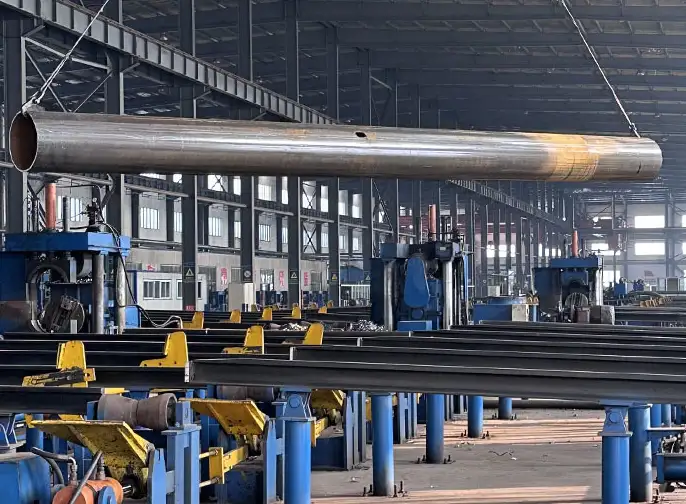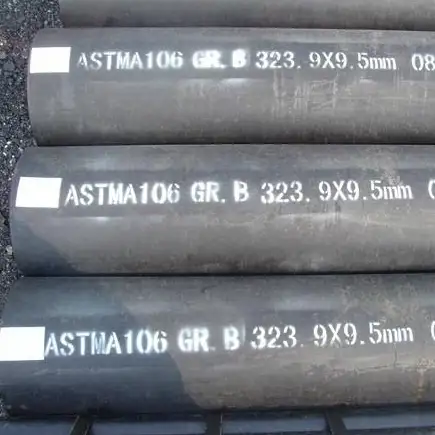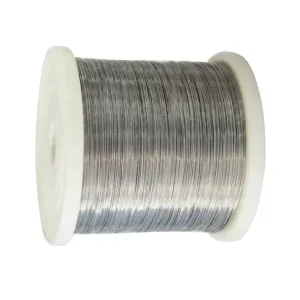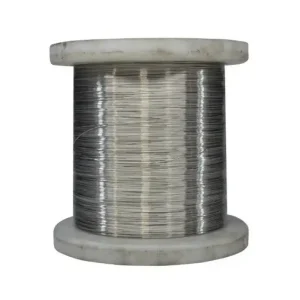The ASTM A106 Grade B Carbon Steel Pipe is widely used in high-temperature applications. At MWalloys, we provide premium-quality pipes that adhere to rigorous industry standards, ensuring excellent performance and durability in industries such as oil and gas, chemical processing, and power generation. The ASTM A106 Grade B pipe is designed to transport gases and fluids under high pressure and temperature conditions, making it an ideal choice for critical applications.
What is ASTM A106 Grade B Carbon Steel Pipe
The ASTM A106 Grade B Carbon Steel Pipe is one of the most reliable and versatile piping materials used in the industry. Known for its superior strength and durability, this pipe is made from carbon steel, which is the preferred material for carrying fluids and gases at high temperatures. The pipe is produced under ASTM A106, a globally recognized standard that specifies the requirements for seamless carbon steel pipe used in high-temperature applications.
ASTM A106 Grade B is the most common grade of the A106 series. It features excellent tensile strength and resistance to high-pressure conditions, making it suitable for a variety of industrial applications. Additionally, this pipe can be used for transporting both liquids and gases under high-pressure environments, such as in power plants, refineries, and natural gas pipelines.
Key Features and Advantages
-
High-Temperature Resistance: ASTM A106 Grade B Carbon Steel Pipe is designed to withstand high temperatures, with capabilities to handle heat up to 750°F (400°C). This makes it ideal for high-pressure steam, water, and other heated fluids in industrial applications.
-
Seamless Construction: These pipes are made without a welded seam, providing higher strength, better pressure resistance, and durability.
-
Corrosion Resistance: Although carbon steel pipes are not as resistant to corrosion as stainless steel, they still offer good performance in most environments, especially when coated or treated.
-
Versatility: This material is used across multiple industries, including the oil and gas, petrochemical, and power generation sectors. It is ideal for applications that require both strength and flexibility in piping systems.
Applications of ASTM A106 Grade B Carbon Steel Pipe
This type of pipe has broad applications due to its versatility and strength. Here are some common uses:
-
Power Plants: It is often used in the transportation of steam and hot water in power plants due to its resistance to high temperatures.
-
Petrochemical Industry: The pipe is essential for carrying high-temperature chemicals and gases.
-
Oil and Gas Industry: It is used for transferring oil and natural gas over long distances, both onshore and offshore.
In addition to the above industries, the ASTM A106 Grade B carbon steel pipe is also found in various other applications requiring strength and heat resistance, such as construction and infrastructure projects.
Standard Overview & Grade Definitions
*(ASTM A106/A106M-2024)*
| Parameter | Specification | Key Notes |
|---|---|---|
| Scope | Seamless carbon steel pipes for high-temperature service (e.g., power plants, refineries, pipelines) | Max temperature: 565°C; Min temperature: -29°C |
| Conflict Priority | 1. Purchase Order > 2. Product Spec > 3. ASTM A106 | Mandatory tests cannot be waived |
| Unit Systems | • Imperial (A106): inch-lb • Metric (A106M): SI units • ⚠️ Mixing units voids compliance |
Metric grades use "Gr" suffix (e.g., A106M Gr.B) |
| Key Equivalent Grades | • China: 20# (GB/T 8163) • EU: P235GH (EN 10216) • Japan: STS410 |
Not fully interchangeable due to Mn/P/S limits |
Chemical Composition Comparison
(Weight %, Melt Analysis)
| Element | ASTM A106 Gr.B | GB/T 8163 20# | A53 Gr.B | Permissible Variation |
|---|---|---|---|---|
| C (Carbon) | ≤0.30 | 0.17–0.24 | ≤0.30 | ±0.01% |
| Mn (Manganese) | 0.29–1.06 | 0.35–0.65 | ≤1.20 | ±0.05% |
| P (Phosphorus) | ≤0.025 | ≤0.035 | ≤0.05 | ±0.005% |
| S (Sulfur) | ≤0.025 | ≤0.035 | ≤0.045 | ±0.005% |
| Si (Silicon) | ≥0.10 | 0.17–0.37 | ≥0.10 | ±0.03% |
💡 Critical Insight: A106 Gr.B’s lower P/S vs. 20# enables -29°C low-temperature use without impact testing (per ASME B31.3).
Mechanical Properties Comparison
(Hot-finished, room temperature)
| Property | A106 Gr.B | A53 Gr.B | API 5L Gr.B | Test Standard |
|---|---|---|---|---|
| Tensile Strength (min) | 415 MPa (60 ksi) | 415 MPa (60 ksi) | 414 MPa (60 ksi) | ASTM E8/E8M |
| Yield Strength (min) | 240 MPa (35 ksi) | 240 MPa (35 ksi) | 241 MPa (35 ksi) | ASTM E8/E8M |
| Elongation (min) | 12% (50mm gauge) | 12% (50mm gauge) | 12% (50mm gauge) | - |
| Hardness (max) | 163 HBW | 179 HBW | 190 HBW | ASTM E10 |
Common Sizes, Thickness & Weight Tables
*(Per ASME B36.10M-2018 Schedule 40/80/160)*
Standard Dimensions & Weights (Schedule 40)
| Nominal Pipe Size (NPS) | OD (mm) | Wall Thickness (mm) | Weight (kg/m) | Pressure Rating (MPa) |
|---|---|---|---|---|
| 1/2" | 21.3 | 2.77 | 1.27 | 20.6 |
| 2" | 60.3 | 3.91 | 5.44 | 17.2 |
| 4" | 114.3 | 6.02 | 16.07 | 13.7 |
| 6" | 168.3 | 7.11 | 28.25 | 11.1 |
| 8" | 219.1 | 8.18 | 42.55 | 9.6 |
Schedule Comparison (6" NPS Example)
| Schedule | Wall Thickness (mm) | Weight (kg/m) | Max Pressure (MPa) | Typical Use |
|---|---|---|---|---|
| 40 | 7.11 | 28.25 | 11.1 | General high-temp flow |
| 80 | 10.97 | 41.67 | 17.2 | High-pressure steam |
| 160 | 15.06 | 54.57 | 24.8 | Critical hydrocarbon lines |
⚖️ Weight Formula:
Metric:Weight (kg/m) = (OD - WT) × WT × 0.02466
Imperial:Weight (lb/ft) = (OD - WT) × WT × 10.69
Special Variants: NACE vs. MR0175 Compliance
(For sour service in H₂S environments)
| Parameter | A106 Gr.B NACE | A106 Gr.B MR0175 |
|---|---|---|
| Standard | ASTM A106 + NACE Corrosion Control Standards | ASTM A106 + NACE MR0175 (Sulfide Stress Cracking) |
| Key Requirement | Enhanced cleanliness, low hardness (<22 HRC) | Strict H₂S resistance, hardness ≤ 22 HRC |
| Processing | Normalized or stress-relieved | Quenched & tempered |
| Applications | • Refinery piping • Chemical transport |
• Oil/gas wells • Sour gas pipelines |
Processing & Application Guidelines
| Aspect | Specification |
|---|---|
| Delivery Condition | Hot-finished, cold-drawn, or normalized |
| Welding | Preheating not required for thickness <20mm; use SMAW, GMAW with low-H electrodes |
| Corrosion Protection | • Epoxy coating (indoor) • 3PE coating (buried pipelines) • Galvanizing (not for >400°C service) |
| Certification | Mill Test Reports (MTRs) with heat analysis, hydrostatic test data, and NACE certs if applicable |
Procurement & Quality Alerts
-
Material Substitution Risk: Factories often use GB 20# billets for both A106B and 20# pipes, but A106B has stricter Mn/P/S limits enabling lower temp use (-29°C vs. -19°C).
-
Critical Tolerances:
-
OD: ±0.79mm (NPS ≤4"), ±1% (NPS >4")
-
WT: +20%/-12.5% (per ASTM A530)
-
-
Surface Defects: Scratches ≤0.1mm depth allowed; deeper defects require grinding within WT tolerance.

Comparing ASTM A106 with Other Grades
| Property | ASTM A106 Grade B | ASTM A53 Grade B | API 5L Grade B |
|---|---|---|---|
| Material | Carbon Steel | Carbon Steel | Carbon Steel |
| Tensile Strength (psi) | 60,000 | 48,000 | 60,000 |
| Yield Strength (psi) | 35,000 | 30,000 | 35,000 |
| Elongation | 20% | 20% | 23% |
| Pressure Rating | High | Medium | High |
| Standard | ASTM A106 | ASTM A53 | API 5L |
In this comparison table, you can see how ASTM A106 Grade B stands out in terms of tensile and yield strength, making it a preferred choice in more demanding applications compared to ASTM A53 and API 5L.
Global Pricing Comparison 2025
The pricing for ASTM A106 Grade B Carbon Steel Pipe can vary depending on factors such as diameter, wall thickness, and location. Below is a general price comparison for this pipe across major regions:
| Region | Price per Ton (USD) | Delivery Time |
|---|---|---|
| China | $550 - $650 | 2-3 weeks |
| USA | $650 - $750 | 1-2 weeks |
| Europe | $700 - $800 | 2-3 weeks |
| India | $500 - $600 | 3-4 weeks |
Why Choose MWalloys for ASTM A106 Grade B Carbon Steel Pipe?
At MWalloys, we prioritize quality and customer satisfaction. Our ASTM A106 Grade B Carbon Steel Pipes are manufactured using the best materials and advanced technology, ensuring that they meet the most stringent industry standards. We offer competitive pricing and prompt delivery to ensure that our clients get the best value for their investment. Our expertise and experience in the piping industry make us a trusted supplier for industries across the globe.
Frequently Asked Questions (FAQ)
-
What are the primary applications of ASTM A106 Grade B Carbon Steel Pipe?
ASTM A106 Grade B Carbon Steel Pipe is commonly used in high-pressure and high-temperature environments. Typical applications include the transport of steam, water, and gases in industries such as power generation, petrochemical, and oil & gas. The pipe is highly valued for its durability and resistance to heat and pressure. -
How does ASTM A106 Grade B compare to other carbon steel pipes?
ASTM A106 Grade B is designed for high-temperature applications, offering superior tensile strength and pressure resistance compared to standard carbon steel pipes like ASTM A53. It is specifically built for seamless construction, which provides enhanced strength and flexibility, making it ideal for critical systems in demanding environments. -
Is ASTM A106 Grade B suitable for low-temperature applications?
No, ASTM A106 Grade B is not designed for low-temperature environments. For such applications, pipes such as ASTM A333 Grade 6 are more appropriate, as they are specifically designed to handle colder temperatures and avoid brittleness. -
What factors affect the price of ASTM A106 Grade B Carbon Steel Pipe?
The cost of ASTM A106 Grade B pipe is influenced by factors like diameter, wall thickness, length, and the quantity ordered. Other market conditions such as raw material prices, shipping, and regional demand also play a significant role in determining the final price. Prices can vary between regions, with competitive pricing found in China, India, and the United States. -
What are the material standards and certifications for ASTM A106 Grade B?
ASTM A106 Grade B Carbon Steel Pipe complies with the ASTM A106 standard, which governs the manufacture of seamless carbon steel pipe for high-temperature service. The pipes are produced to meet rigorous testing and quality control requirements, ensuring compliance with international standards for material strength, yield strength, and elongation. Certification details can often be provided upon request. -
How do I choose the right ASTM A106 Grade B pipe for my project?
Selecting the right ASTM A106 Grade B pipe involves considering the temperature, pressure, and type of fluid or gas being transported. It's important to consult with an expert to determine the optimal pipe size, wall thickness, and material for your specific application. At MWalloys, we provide technical support to help you choose the best solution for your needs.





